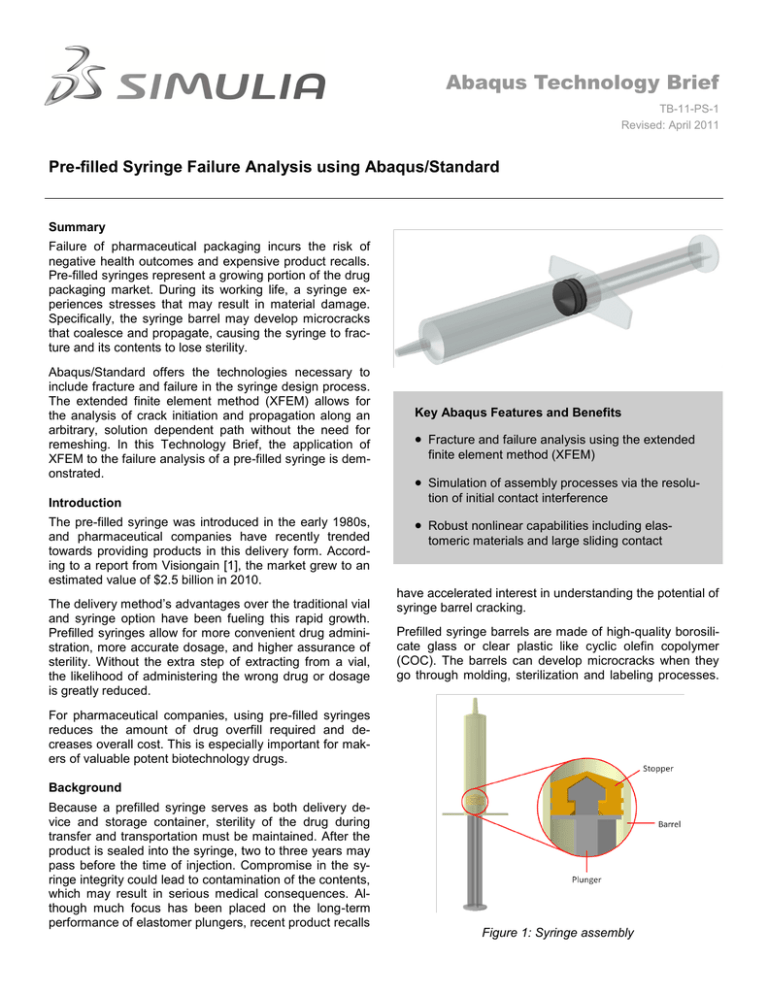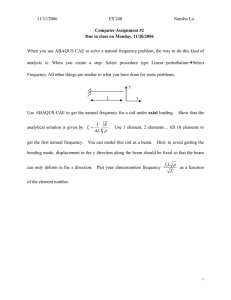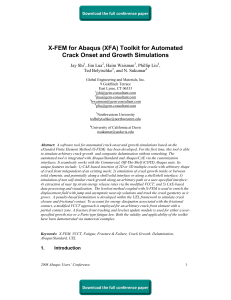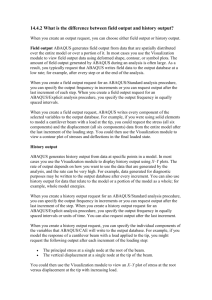Abaqus Technology Brief Pre-filled Syringe Failure Analysis using Abaqus/Standard
advertisement

Abaqus Technology Brief TB-11-PS-1 Revised: April 2011 Pre-filled Syringe Failure Analysis using Abaqus/Standard Summary Failure of pharmaceutical packaging incurs the risk of negative health outcomes and expensive product recalls. Pre-filled syringes represent a growing portion of the drug packaging market. During its working life, a syringe experiences stresses that may result in material damage. Specifically, the syringe barrel may develop microcracks that coalesce and propagate, causing the syringe to fracture and its contents to lose sterility. Abaqus/Standard offers the technologies necessary to include fracture and failure in the syringe design process. The extended finite element method (XFEM) allows for the analysis of crack initiation and propagation along an arbitrary, solution dependent path without the need for remeshing. In this Technology Brief, the application of XFEM to the failure analysis of a pre-filled syringe is demonstrated. Introduction The pre-filled syringe was introduced in the early 1980s, and pharmaceutical companies have recently trended towards providing products in this delivery form. According to a report from Visiongain [1], the market grew to an estimated value of $2.5 billion in 2010. The delivery method’s advantages over the traditional vial and syringe option have been fueling this rapid growth. Prefilled syringes allow for more convenient drug administration, more accurate dosage, and higher assurance of sterility. Without the extra step of extracting from a vial, the likelihood of administering the wrong drug or dosage is greatly reduced. Key Abaqus Features and Benefits Fracture and failure analysis using the extended finite element method (XFEM) Simulation of assembly processes via the resolution of initial contact interference Robust nonlinear capabilities including elastomeric materials and large sliding contact have accelerated interest in understanding the potential of syringe barrel cracking. Prefilled syringe barrels are made of high-quality borosilicate glass or clear plastic like cyclic olefin copolymer (COC). The barrels can develop microcracks when they go through molding, sterilization and labeling processes. For pharmaceutical companies, using pre-filled syringes reduces the amount of drug overfill required and decreases overall cost. This is especially important for makers of valuable potent biotechnology drugs. Background Because a prefilled syringe serves as both delivery device and storage container, sterility of the drug during transfer and transportation must be maintained. After the product is sealed into the syringe, two to three years may pass before the time of injection. Compromise in the syringe integrity could lead to contamination of the contents, which may result in serious medical consequences. Although much focus has been placed on the long-term performance of elastomer plungers, recent product recalls Figure 1: Syringe assembly 2 simulate the effect of microcracks developed during manufacture (Figure 2). Figure 2: Initial crack inserted in the inside surface of the barrel at a 45 degree angle to the barrel axis The plunger insertion was simulated by resolving contact interference between the stopper and the barrel. After assembly, frictional contact was assumed between the barrel and rubber stopper. Fluid pressure inside the closed cavity was then applied as a linear function of time to simulate the increase in pressure as the plunger was inserted into the barrel. XFEM was used to model the propagation of the initial crack due to stress around the crack front. Results and Discussion The microcracks may not be detectable at the time of quality inspection. As the barrels with microcracks undergo deformation during plunger insertion, packaging, transportation and handling, the cracks may propagate if the stress around the crack front reaches a critical level. If the cracks extend far enough and create a pathway for microbiological contamination to reach the sealed drug, sterility will be compromised. The nonlinear analysis capabilities of Abaqus/Standard have long been helping manufacturers analyze the sealing integrity of syringes [2, 3]. In addition, Abaqus capabilities in fracture and failure analysis have been used in the prediction of medical device failure [4]. The Abaqus implementation of XFEM is a powerful tool for predicting crack initiation and propagation independent of the finite element mesh. In this study we illustrate how this advanced fracture analysis technique can be used to study the likelihood of a crack causing the loss of sealing integrity in a syringe barrel. Analysis Approach A plastic syringe assembly was created using Abaqus/ CAE. The model includes a barrel, plunger, and stopper (Figure 1). The barrel is comprised of Topas® COC grade 5013 plastic. An initial crack on the inner surface of the syringe, at 45 degrees to the barrel axis, was inserted to (a) (b) (c) Figure 3: Propagation of the crack as the pressure increases As the pressure increases, the crack first extended onto the exterior surface of the barrel (Figure 3a) indicating the loss of sterility of the drug inside the syringe. It then traveled along the circumferential direction of the barrel (Figures 3b-c). In this example, the size and location of an initial flaw is assumed. In general, it is not necessary with the XFEM method to specify an initial crack; the approach can predict where cracking will begin. However, this simulation is meant to represent a worst-case scenario given that the crack is positioned immediately adjacent to the plunger stopper, where high stress is expected due to the sealing pressure the stopper asserts on the barrel. A systematic approach is required to study various combinations of initial crack location, size and orientation. Some of them may not propagate at all under the operating loading conditions, while others may propagate only along either the interior or exterior surface of the barrel and will not cause loss of sterility. Such knowledge could provide guidelines for improving manufacturing and quality control processes. Conclusion The utility of XFEM for assessing the propensity of a plastic syringe barrel to crack during assembly has been demonstrated. Similar to prefilled syringes, XFEM may also be used to study fracture and failure in other drug delivery devices such as automatic injectors and cartridges. Other fracture and failure analysis techniques are available in Abaqus/Standard for the study of pharmaceutical package sealing properties; for example, debonding of blister packs could be modeled with cohesive elements. These techniques could help drug delivery and pharmaceutical packaging designers develop more reliable, longer lasting devices that would ultimately benefit the industry and its patients. 3 References 1. Visiongain. Prefilled syringes and related systems: world market outlook 2010-2025. London, U.K.; April 22, 2010. 2. Bestelmeyer, A. M., BD Technologies, "Optimizing Medical Product Designs Using ABAQUS," ABAQUS Users' Conference, Newport, Rhode Island, June 2000, pp. 1 – 16. 3. Hansen, T., Novo Nordisk A/S, "Virtual Medical Device Optimization Using ABAQUS," ABAQUS Users' Conference, Stockholm, Sweden, May 2005, pp. 185 – 199. 4. Goyal, D., Reiterer, M., Conard, B., Medtronic, Inc., "Fracture Analysis of the Battery Cans for Implantable Pulse Generators," SIMULIA Customer Conference, Providence, Rhode Island, May 2010, pp. 733 - 745. Abaqus References For additional information on the Abaqus capabilities referred to in this brief, please see the following Abaqus 6.11 documentation references: Analysis User’s Manual ‘Modeling discontinuities as an enriched feature using the extended finite element method,’ Section 10.7.1 ‘Modeling contact interference fits in Abaqus/Standard,’ Section 34.3.4 About SIMULIA SIMULIA is the Dassault Systèmes brand that delivers a scalable portfolio of Realistic Simulation solutions including the Abaqus product suite for Unified Finite Element Analysis, multiphysics solutions for insight into challenging engineering problems, and lifecycle management solutions for managing simulation data, processes, and intellectual property. By building on established technology, respected quality, and superior customer service, SIMULIA makes realistic simulation an integral business practice that improves product performance, reduces physical prototypes, and drives innovation. Headquartered in Providence, RI, USA, with R&D centers in Providence and in Suresnes, France, SIMULIA provides sales, services, and support through a global network of over 30 regional offices and distributors. For more information, visit www.simulia.com The 3DS logo, SIMULIA, Abaqus and the Abaqus logo are trademarks or registered trademarks of Dassault Systèmes or its subsidiaries, which include Abaqus, Inc. Other company, product and service names may be trademarks or service marks of others. Copyright Dassault Systèmes, 2011


